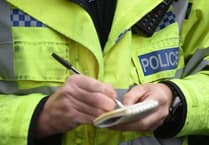THERE’S been some spooky goings on in North Cornwall recently, — could the Beast of Bodmin Moor be lurking?
Sightings of a large, black cat have been reported across North Cornwall, including the Port Isaac and St Tudy area, Bodmin and Rock. The legend of the Beast of Bodmin Moor was the thought circulating in everyone’s minds, writes Rosie Cripps.
Martin Whitehouse, 55, the manager of the shop on site at St Minver Holiday Park said an elderly gentleman had come into the shop for his morning paper, when he asked if reports of a ‘big, black panther-looking cat’ had been made. Martin told him that nothing had been said of this throughout the season.
He said: “He then told me that Tuesday evening [October 24] his middle aged daughter and a friend were walking back to their caravan around 6.30pm, when they spotted, in front of one of the caravans, a large black cat.
“He said it was higher than the bottom of the caravans, which are about two feet off the ground. She told him that it was prowling in front of the caravan when they saw it. It then stopped and looked at them for about 30 seconds, and then slunk off around the caravan and into the undergrowth.”
Having mentioned the incident to the receptionist at the holiday park, Martin soon realised that this wasn’t just a one-off.
He added: “I reported the incident to the head receptionist later that morning, and he told me that somebody had reported seeing a large black cat in the same area last week. So that’s twice in a week it has been seen!”
And a one-off it wasn’t. A large cat has also allegedly been spotted by holidaymakers staying at Trevenning Barn, located between St Tudy and Port Isaac, where it was said that locals were ‘not surprised’ to hear about the sighting.
North Cornwall is no stranger to its myths and legends. However, the Beast of Bodmin Moor is a fairly recent theory.
Over 60 sightings of large cats have reportedly been seen since 1983. People believe there are at least one or more wild cats roaming the moors in Cornwall and Devon.
Just a few years ago, an animal’s skull with large fangs was found in the River Fowey on Bodmin Moor. The Natural History Museum confirmed that it was the skull of a male leopard.
The British Big Cats Society (BBCS), based at Dartmoor Wildlife Park, is an organisation aiming to protect and prove the presence of wild cats in the UK. It is in the process of becoming a charity.
Founder of the society, Danny Bamping, explained that the reason for big cats roaming moorlands and areas of the UK are due to the introduction of the Dangerous Wild Animals Act of 1976, when people were required to hold a license if they were to own an animal such as a wild cat.
The license was required for all animals listed under the Dangerous Wild Animals Act, and an individual that held a license was to be the person who kept the animal, with the animal being kept at a premises specified in the license. The license also requested that the license-holder was to have some insurance policy in place in case the animal was to cause damage.
Danny said: “In 1976, the Dangerous Wild Animals Act was brought into the UK, which is why we’ve got big cats in the country. So people that wanted to have exotic pets had to have a license from 1976 to hold it. Lots of people in the South West had cats, which was then changed after the new licensing law was put into place. In places like Harrods it’s very different. People could just go in and walk out with a cheetah on a lead; it’s quite unbelievable.”
With the introduction of the Dangerous Wild Animals Act in the 70s, many people were left stumped with what to do with big cats in their possession. Danny continued: “There was a number of people who had big cats. They had a choice — they could put them down, put them in a zoo or place them in an enclosure and get an expensive license that would have cost a couple of grand, which, in the 1970s, was a lot of money.”
He explained that the government at the time did not anticipate the number of wild cats in the country, and it was not made illegal to release the cats into the wild until the introduction of the 1981 Countryside Act. The cats seen today could be offspring from the original cats released in the 1970s and 80s.
Danny said: “You’ve got to look at the species. The majority of sightings are of large black cats. This can’t be dismissed. They could be hybrids, but there are certain species out there.
“People are also mistaken a lot of the time, with large domestic cats, etc. So there are a lot of possibilities. Sightings within a couple of days can lead to people saying the ‘Beast of Bodmin Moor’, the ‘Beast of Exmoor’, the ‘Beast of Dartmoor’ — I don’t like calling them ‘beast’, because they’re cats.”
Danny also told the Post that wild cats can only be considered ‘big cats’ scientifically if they can produce a roar. He said: “They’re only ‘big cats’ if they’re able to roar, so animals such as lions and leopards, they can roar, but cats like the lynx and panther can’t roar, so, scientifically, they’re not big cats.
“The story of the Beast of Bodmin Moor has being going on for years, and there’s lots of theories surrounding how the cats got into the wild in the first place.”
The BBCS allows people to report sightings to their website, which enables them to ‘react appropriately when necessary’, with the society being in contact with the police, DEFRA and wildlife organisations in dealing with big cat sightings.
With farmers’ livestock threatened during the 1970s and 80s, with big cats reportedly mauling them, Danny told the Post that anyone worried about livestock or their own safety should take the appropriate steps.
He said: “If people think their livestock is being attacked by big cats, they need to contact the vets and also the police. Take pictures and document it, which people very often don’t do.
“Sightings have been there for years — for over 30 or 40 years — and it’s not just Bodmin Moor. The police are busy catching criminals, and have no idea about big cats, but if you are going to contact the police about a sighting, make sure you speak to the local wildlife crime liaison officer — there’s one for each area — and do can this on 101. You can also reach us confidentially on our website to report a sighting.”
In 2010, Freedom of Information requests were made, which revealed that a total of 4,296 animals were held with a license under the Dangerous Wild Animals Act, 1976. Of these, 137 were wild cats.
To find out more information and report a sighting, visit www.britishbigcats.org/report.
- Have you spotted anything unusual in your area? Get in touch by emailing [email protected]




